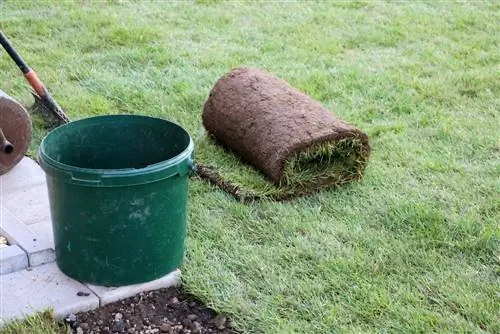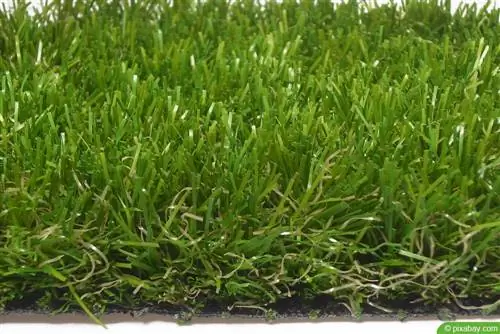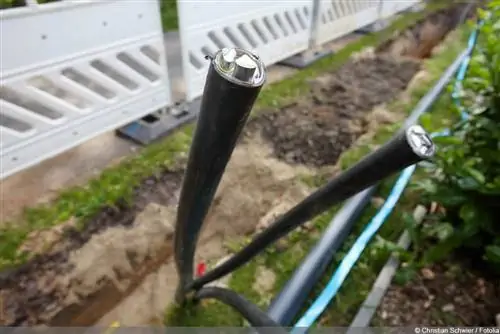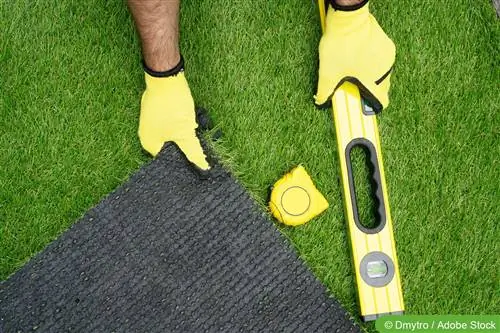- Author admin [email protected].
- Public 2023-12-17 03:39.
- Last modified 2025-01-24 12:45.
Rolled turf is considered by many hobby gardeners to be a safe alternative to the laborious task of sowing and growing lawn. With the right preparation and the right time for installation, it is almost guaranteed to succeed. We also explain everything worth knowing about fertilizing and caring for turf so that you can achieve your goal successfully with our instructions.
The cost of turf
Hardly any gardener would not be happy to have a lawn that is immediately green and can be used and played on within a short period of time. But whether rolled turf is actually an alternative to classic sowing depends on the costs. Compared to normal lawn seeds, rolled turf costs a significantly higher price. Logically, the effort for sowing, fertilizing, mawing and general care also needs to be paid for. The prices per square meter for different lawn products vary depending on the following factors:
- Type of lawn (shade lawn, football lawn, ornamental lawn, etc.)
- Purchase quantity (unit price decreases as quantity increases)
- Delivery or collection
- Delivery on desired date, above collection from warehouse
Numerous offers are in the range between five and ten euros per square meter, although luxury products or rolled turf with additional supplementary products from fertilizer to weed protection are more expensive, while special offers can also be lower. Added to this are the costs for preparing the lawn.
NOTE:
Lawn seeds for self-sowing are already available in a price range of around 20 to 30 cents per square meter, with the container size, the type of lawn and the actual consumption by the gardener when sowing the seeds being the biggest influencing factors on the costs. Here, too, the costs for the preparation of the substrate are not included, so the comparison between rolls costing approx. 7.50 EUR and seeds costing approx. 0.25 EUR illustrates the difference.
When to publish?

Once the decision has been made in favor of a pre-cultivated lawn from the roll, the right time for laying determines the next steps. Although the lawn can theoretically be laid all year round with the exception of winter, each season offers its own advantages and disadvantages and is therefore a little better or less suitable than the other periods:
Spring
- Already good sunlight as a source of heat and energy
- Free from night frosts after the Ice Saints at the latest
- Regular showers for good watering
Summer
- High temperatures for high growth
- A lot of sun as a supplier of energy for photosynthesis
- Only low rainfall, growth therefore only ensured with artificial irrigation
Autumn
- Falling temperatures for slower growth
- Poor rooting in the subsoil due to onset of frosts
- Good water supply due to increasing rainfall
In conclusion, it can be said that summer and autumn are still partially suitable for laying turf and, especially in summer, disadvantages can be compensated for by artificial irrigation. However, the ideal time is spring after the night frosts have subsided. The preparatory work can then be carried out easily in moist but no longer frozen ground. The time from May is particularly suitable, when low temperatures and frost are finally a thing of the past.
The preparation
When the desired turf rolls are delivered or picked up from the supplier, the subsoil in the home garden must have already been prepared and meet all the requirements for receiving the turf:
Tools required:
- Spade
- Garden rake
- Tiller
- Lawn roller
Excipients:
Sand
Instructions step by step
- If present: Remove old turf or other old growth and compost or dispose of it
- Over time or due to construction work, thoroughly loosen heavily compacted ground with a motor hoe
- For heavy, clayey soils, spread sand evenly over the soil and work it in with a motor hoe
- Collect larger stones, pieces of roots and other foreign bodies
- Check the pH value of the soil, if there are large deviations from the optimal range, check it by 6.8 to 7.5 (e.g. with pH test strips)
- If soils are too acidic, incorporate lime moderately
- If the soil is too alkaline, incorporate humus or mulch made from coniferous bark
- Level the surface with a rake and smooth it out
- Roll the soil to the required density with a lawn roller (otherwise there will be no support for the roots and excessive settlement)
- After rolling, level out any noticeable bumps, hills or dents with a rake and roll again
Now that the garden is ready for turf, it should rest for at least a week. During this time the earth can settle again. There is also the positive side effect that weed seeds present in the soil germinate and the plants can be removed before laying the lawn.
Tip:
A motor hoe and a garden roller can be rented from almost any hardware store, so that the costs can be kept very low!
Laying
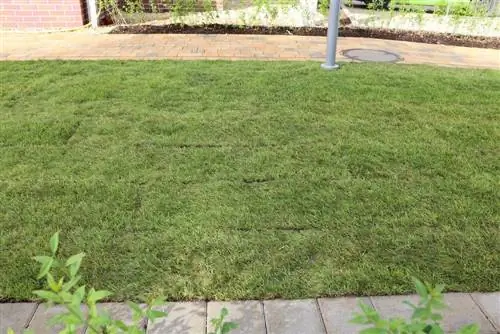
Now it's time to actually lay the lawn rolls. If you work here cleanly and conscientiously, you will already be well on the way to a lush green lawn without gaps.
Tools required:
- Old kitchen knife or other blade of sufficient length
- Garden roller
Excipients:
Complete mineral fertilizer, e.g. blue grain
Instructions step by step
- Fertilize the area to be covered evenly according to the manufacturer's instructions to ensure a good supply of nutrients during growth
- Rolling out grass from one corner of the garden
- Connect the following rollers tightly and avoid gaps between lawn strips
- Avoid cross joints and overlaps
- Cut out or adjust the lawn with a knife in the edge area and around obstacles
- After complete installation, press the lawn with a lawn roller to create good contact between roots and soil
- Guide the roller in longitudinal and transverse paths to avoid displacements and opening joints
- Water laid and rolled lawn with a good 15 to 20 liters per square meter
Care
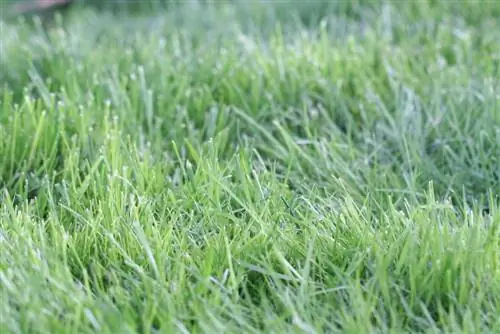
Done, you have successfully laid your lawn rolls and are looking at a closed lawn area in strong green. To ensure that the joy lasts, it is important to take proper care in the following weeks and months so that growth is successful and the lawn grows firmly and permanently into the ground. In addition to watering, essential components of care include mowing and fertilizing.
Pouring
After around two weeks, the roots of the lawn plants have grown sufficiently into the subsoil to obtain the required water from there. Until then, the turf should be kept permanently moist, deep down to the roots. To ensure this, it must be watered at least daily, but ideally in the morning and evening. When it rains, watering can of course be omitted, while when it is very dry and warm temperatures the amount of water should be increased.
Mowing
A lawnmower with properly sharpened blades is the method of choice when it comes to stimulating lawn growth through targeted mowing:
- First cut after 8 to 14 days
- Do not make the first cut deeper than five centimeters
- Maximum growth height up to the first cut about 7 to 10 centimeters
- Then mow weekly to no less than four centimeters
Tip:
If a lawn is mowed deeper than approximately four centimeters, the risk of burning increases due to intense sunlight on the leaf bases and like roots in the soil!
Fertilize
The starter fertilizer is usually sufficient for around six weeks of nutrient supply. The lawn should then be fertilized three to four times with suitable lawn fertilizer over the rest of the growing season. However, if long-term fertilizer is used, the frequency can be reduced according to the manufacturer's instructions.

